数组+链表结构
1.扩容线程的不安全,头插法造成死循环,这个过程出现在扩容的过程中
主要的扩容代码如下,使用的是头插法
【参考1】
do {
Entry<K,V> next = e.next;//取出第一个元素
int i = indexFor(e.hash, newCapacity);
e.next = newTable[i];
newTable[i] = e;
e = next;
} while (e != null);
正常的ReHash的过程(单线程):
假设了我们的hash算法就是简单的用key mod 一下表的大小(也就是数组的长度)。
最上面的是old hash 表,其中的Hash表的size=2, 所以key = 3, 7, 5,在mod 2以后都冲突在table[1]这里了。
接下来的三个步骤是Hash表 resize成4,然后所有的<key,value> 重新rehash的过程。
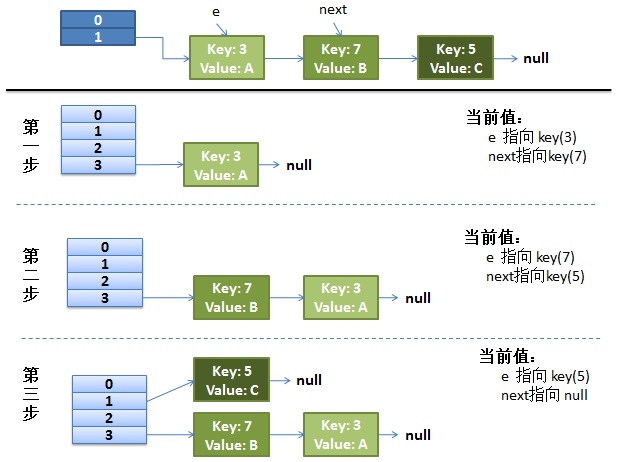
并发下的Rehash(多线程)
1)假设我们有两个线程。
而我们的线程二执行完成了。于是我们有下面的这个样子:
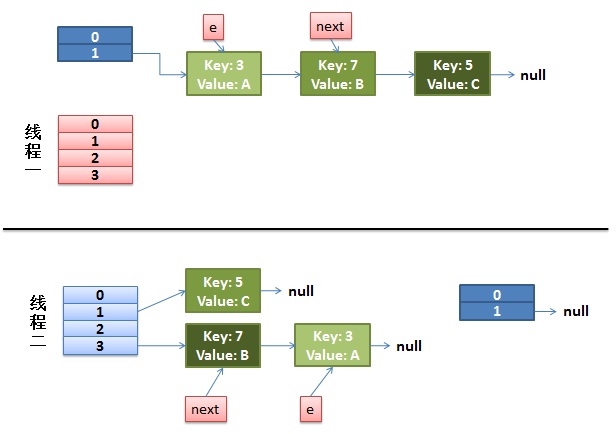
注意,因为Thread1的 e 指向了key(3),而next指向了key(7),其在线程二rehash后,指向了线程二重组后的链表。我们可以看到链表的顺序被反转后。在这里线程一变成了操作经过线程二操作后的HashMap。
2)线程一被调度回来执行。
先是执行 newTalbe[i] = e;
然后是e = next,导致了e指向了key(7),
而下一次循环的next = e.next导致了next指向了key(3)。
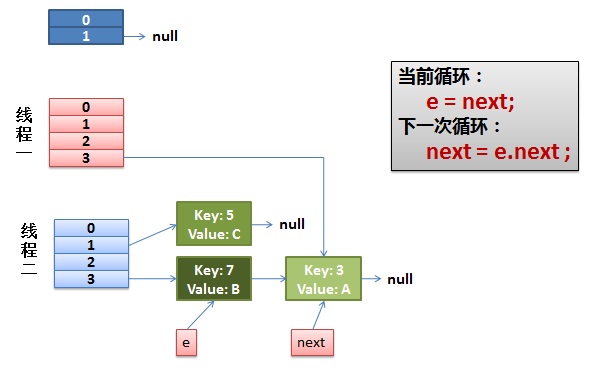
3)一切安好。
线程一接着工作。把key(7)摘下来,放到newTable[i]的第一个,然后把e和next往下移。这个元素所在的位置上已经存放有其他元素了,那么在同一个位子上的元素将以链表的形式存放,新加入的放在链头,而先前加入的放在链尾。
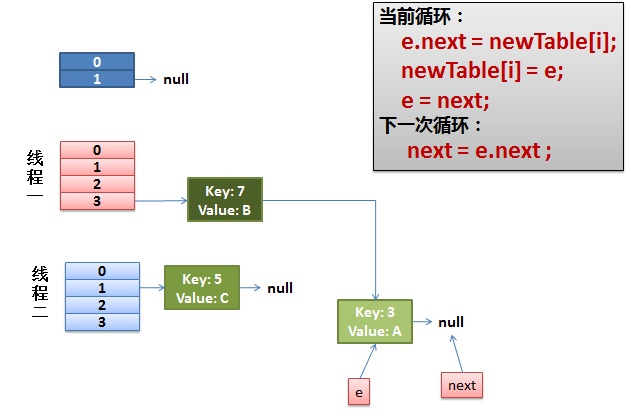
4)环形链接出现。
e.next = newTable[i] 导致 key(3).next 指向了 key(7)。
注意:此时的key(7).next 已经指向了key(3), 环形链表就这样出现了。
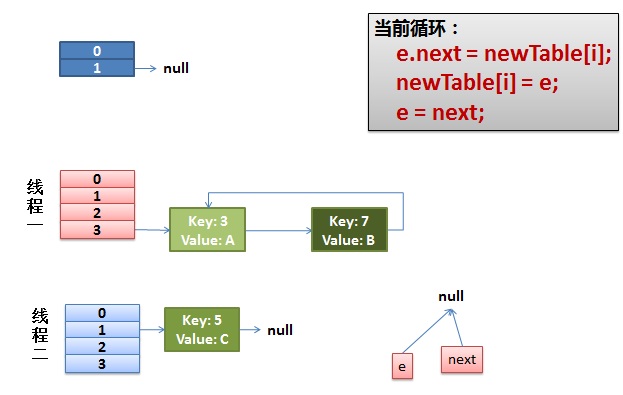
结构:数组+链表+红黑树
public V put(K key, V value) {
return putVal(hash(key), key, value, false, true);
}
/**
* Implements Map.put and related methods.
*
* @param hash hash for key
* @param key the key
* @param value the value to put
* @param onlyIfAbsent if true, don‘t change existing value
* @param evict if false, the table is in creation mode.
* @return previous value, or null if none
*/
final V putVal(int hash, K key, V value, boolean onlyIfAbsent,
boolean evict) {
Node<K,V>[] tab; Node<K,V> p; int n, i;
if ((tab = table) == null || (n = tab.length) == 0)
n = (tab = resize()).length;
if ((p = tab[i = (n - 1) & hash]) == null)
tab[i] = newNode(hash, key, value, null);
else {
Node<K,V> e; K k;
if (p.hash == hash &&
((k = p.key) == key || (key != null && key.equals(k))))
e = p;
else if (p instanceof TreeNode)
e = ((TreeNode<K,V>)p).putTreeVal(this, tab, hash, key, value);
else {
for (int binCount = 0; ; ++binCount) {
if ((e = p.next) == null) {
p.next = newNode(hash, key, value, null);
if (binCount >= TREEIFY_THRESHOLD - 1) // 此处,大于8的时候进行树化,但是treeifyBin中还有判断条件
treeifyBin(tab, hash);
break;
}
if (e.hash == hash &&
((k = e.key) == key || (key != null && key.equals(k))))
break;
p = e;
}
}
if (e != null) { // existing mapping for key
V oldValue = e.value;
if (!onlyIfAbsent || oldValue == null)
e.value = value;
afterNodeAccess(e);
return oldValue;
}
}
++modCount;
if (++size > threshold)
resize();
afterNodeInsertion(evict);
return null;
}
final void treeifyBin(Node<K,V>[] tab, int hash) {
int n, index; Node<K,V> e;
if (tab == null || (n = tab.length) < MIN_TREEIFY_CAPACITY)//如果小于64那么先进行扩容
resize();
else if ((e = tab[index = (n - 1) & hash]) != null) {//否则才进行树化
TreeNode<K,V> hd = null, tl = null;
do {
TreeNode<K,V> p = replacementTreeNode(e, null);
if (tl == null)
hd = p;
else {
p.prev = tl;
tl.next = p;
}
tl = p;
} while ((e = e.next) != null);
if ((tab[index] = hd) != null)
hd.treeify(tab);
}
}
1.8中会出现数据覆盖的情况
举例子:(假设两者put的数据在hash表中不存在)假设A,B两个线程,A线程与B线程都要进行put,且计算的hash索引位置相同,那么当A计算判断完没有,此时时间片用完,B判断完没有在尾部插入后,此时A接着完成插入,那么就会覆盖掉B插入的数据
如何保证了线程安全?
使用了CAS+sychronized实现并发或者更新操作
| 区别 | jdk1.7 | jdk1.8 |
|---|---|---|
| 结构 | 数组(entry)+链表 | 数组(node)+链表+红黑树 |
| 扩容 | 先扩容后插入 | 先插入后扩容 |
| 插入 | 头插法 | 尾插法 |
| 哈希值的计算 | 将原哈希值和左移20位、左移12位、左移7位、左移4位的四个值,一起异或运算(^)。参考 https://blog.csdn.net/u013490280/article/details/108860964 | 将原哈希值和左移16位的值,一起异或运算(^)。 |
| 扩容策略 | 1.7中是只要不小于阈值就直接扩容2倍 | 而1.8的扩容策略会更优化,当数组容量未达到64时,以2倍进行扩容,超过64之后若桶中元素个数不小于7就将链表转换为红黑树,但如果红黑树中的元素个数小于6就会还原为链表,当红黑树中元素不小于32的时候才会再次扩容。 |
| 下标计算 |
| 区别 | jdk1.7 | jdk1.8 |
|---|---|---|
| 结构 | 使用segment+hashEntry | 使用node数组 |
| 冲突后 | 链表 | 树化或链表 |
| 插入 | 先扩容后插入 | 先插入后扩容 |
参考
原文:https://www.cnblogs.com/AI-Creator/p/14748696.html